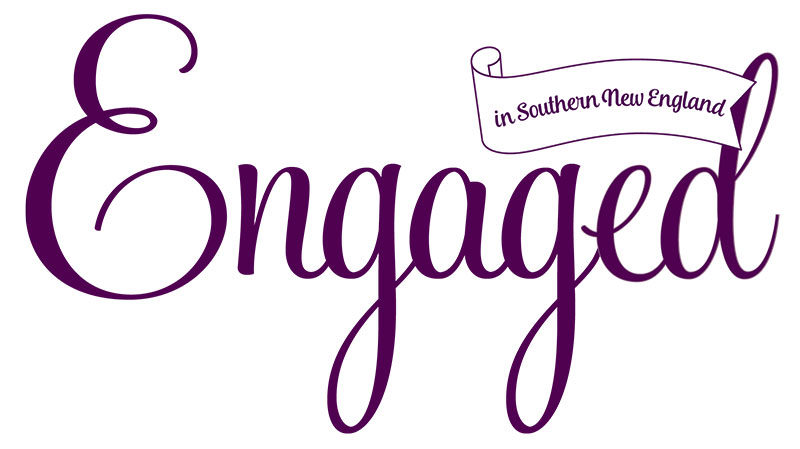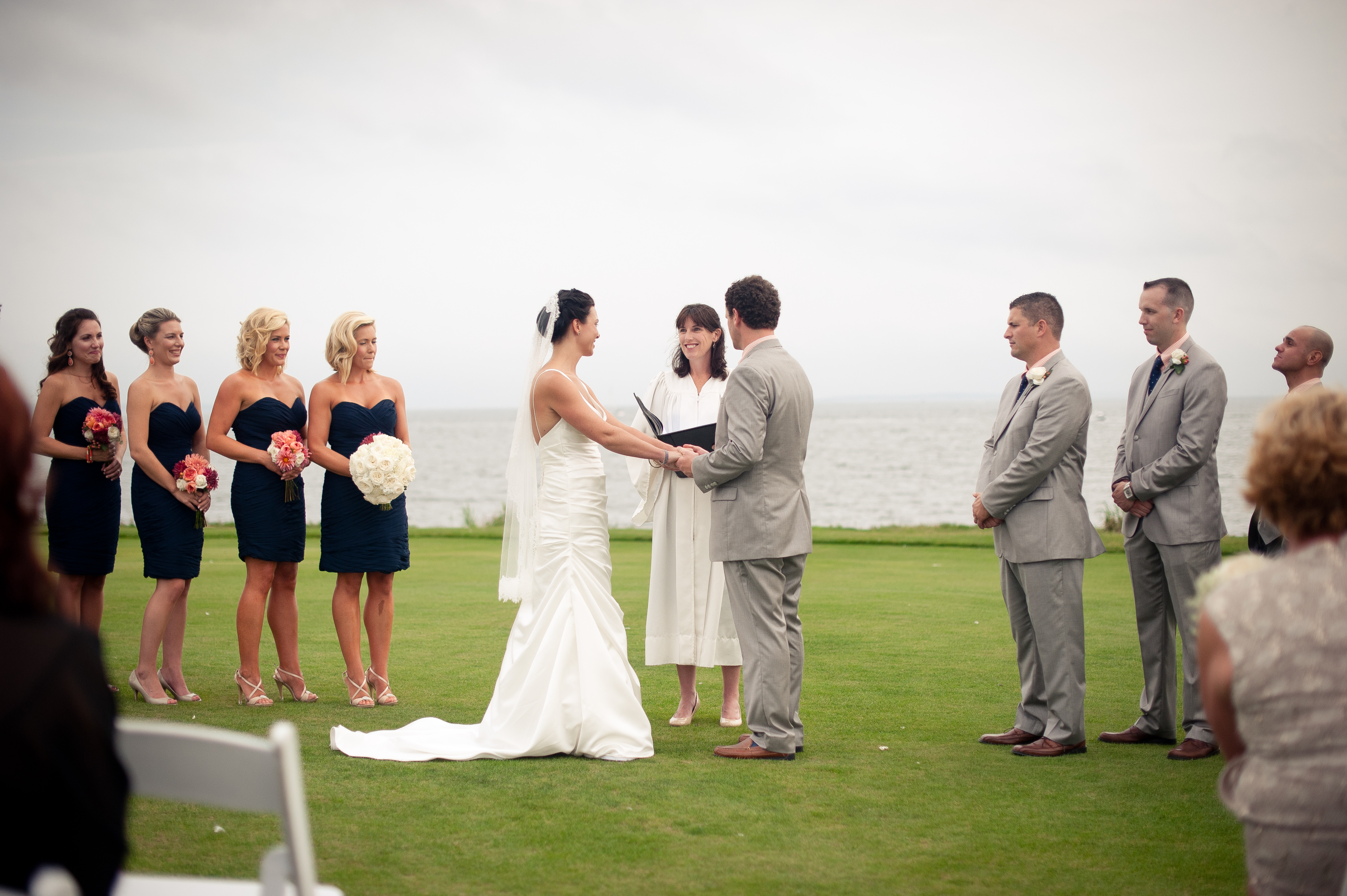Not sure how to say ‘I love you’ during your ceremony? From pop culture to literature, inspiration springs eternal.
Non-denominational minister Deborah C. Faith officiates at the ceremony of Chelsea and Chris Ursillo. Photo by Chris and Amanda Photography and Films.
By Kristina Reardon
As I sat down in an interfaith chapel in neighboring Massachusetts one Sunday morning, I noticed a piece of thick white cardstock tucked between the pages of a hymnal in the pew. It was a program for a wedding that had taken place the day before, and the elements of the ceremony were pressed onto the pages with gold and black ink. Everything looked classic and traditional except for the vows that were featured and re-printed on the back:
i carry your heart with me (i carry it in
my heart) i am never without it (anywhere
i go you go, my dear….”
In place of the traditional “I do,” the couple had recited e.e. cummings’ poem “i carry your heart” to each other. If you’re not opting for a strictly religious ceremony, consider including readings and vows outside the traditional canon that mean something to you as a couple. But where to turn for ideas and inspiration? I turned to non-denominational minister Deborah C. Faith, of Warwick, who shared some of her favorites.
FOR CREATIVE TYPES. You can try to write your own readings, but reaching back to the early days of your relationship might work even better.
Faith worked with one couple that turned to a stash of old greeting cards they had sent each other while they were dating. For one of the readings, they selected the text of the first Hallmark card the groom mailed to the bride.
“Readings set the tone of the ceremony,” Faith says. “They also become part of the voice of who the couple is.”
Some couples have found that voice in movies. One popular reading, Faith notes, comes from the 1998 movie Meet Joe Black, which was filmed at the Aldrich Mansion in Warwick. At one wedding, she remembers the bride’s father read the same text as the father in the film.
“They were both actors,” Faith says. “They were bringing in the acting. Her dad was really feeling that.”
The reading begins: “Love is passion, obsession, someone you can’t live without. If you don’t start with that, what are you going to end up with?”
Others look to shared interests, like favorite children’s books. Rhode Island couple Caleb and Rose Martin chose a section from the Margery Williams’ classic The Velveteen Rabbit. “Real isn’t how you are made,” the Skin Horse tells the Velveteen Rabbit in the passage. “It’s a thing that happens to you. When someone loves you for a long, long time….”
To commemorate the ceremony, you could eschew the traditional music that comes along with your photo montage and replace it with a recording of the readings and your vows.
FOR THE THEME-HAPPY COUPLE. Another option is to look to your date, venue or theme for inspiration for a warm welcome to the ceremony.
Faith remembers that one Halloween-loving couple ditched formalwear and asked their guests to come to the ceremony in costumes. The groom came dressed as Darth Maul from Star Wars, and they brought everything together in an original welcome message that preceded the ceremony, though they used more traditional readings and vows.
For a beach wedding, Faith says one couple turned to a poem written by Maya Angelou, “Love Builds Up the Broken Wall,” which contains nautical references:
Love keeps the stars in the firmament
and imposes rhythm on the ocean tides
each of us is created of it
and i suspect
each of us was created for it.”
Relying on a theme for inspiration can help tie the whole event together, says Faith, since a line or a phrase from the welcome or a reading can be used in the programs or on small placards at the tables at the reception. Or, you can be more creative. At a beach wedding in Jamestown, one of the brides Faith worked with wrote the wedding prayers on rocks, which the guests threw into the ocean as a send-off.
“You can bring it to life,” Faith says, also remembering one wedding where the symbolic items mentioned in one of the readings — wine, salt, bread and a silver coin — were placed at the lectern — and could be taken home with the couple afterwards as a memory of their wedding day.
FOR THE FAMILY ORIENTED. Though parents can often be the hardest to convince of a non-traditional approach,
involving them or other family members in the readings can help sway them. Faith has seen weddings where both mothers do a reading and serve as witness, for example. Or, sometimes offering up a simple “Our Father” or another prayer at some point during an otherwise non-traditional ceremony can strike the right balance.
At one wedding at the Hyatt in Newport, a bride chose to do just that — and the groom’s mother thanked Faith afterwards. “She said, ‘Thank you so much for bringing God into the ceremony in the final prayer’, ” Faith remembers. “She felt that connection.”
If your family is multi-lingual, you can find ways to incorporate unique cultural flourishes to the ceremony. One bride’s professor father found a Polish reading that spoke to the family’s heritage. Another bride’s Italian grandmother offered up a blessing in her native language as part of one ceremony, Faith says. Still another bride asked her aunt to do a reading, and it was her voice and expression that lent the text more meaning. “It left the construct of being on a piece of paper,” Faith remembers. “It was really from the heart.”
If you are gaining not just a spouse but children with a marriage, you can consider talking to your officiant to write children’s vows, which you as a couple can speak to the children involved, while they present you with the rings.
FOR THE MINIMALIST. While Faith notes that one to three readings at three-quarters of a page each is best, some couples skip readings altogether, or choose much shorter texts. Others opt for traditional readings, or fragments of traditional readings, without identifying the source. Faith cites the example of the couple who used a piece of the famous Corinthians verse which references faith, hope and love.
“Some knew it was from the Bible, while others did not,” she says. “They didn’t want to offend anybody with a religious overtone.”
Another couple asked the best man to read the children’s book I Like You, by Sandol Stoddard Warburg, which has simple pen and ink sketches. “It was very playful, whimsical and honest,” Faith says.
Instead of, or alongside, readings, Faith has also seen a group blessing printed in the programs, which the audience recited together. “It has to be the right reading and the right tone,” she says, “but you feel love, strength. The couple feels like it’s a really warm hug to hear the voices.”
Ultimately, it’s best to sit down at home with your fiance and start talking honestly about how you feel for each other — and which words you might use to express that. The most important thing to ask yourself, Faith says, is “Does this really represent how I feel?”
At the end of the day, of course, that is all that matters.


Nicely done .. we’ll be happy to share with our clients !